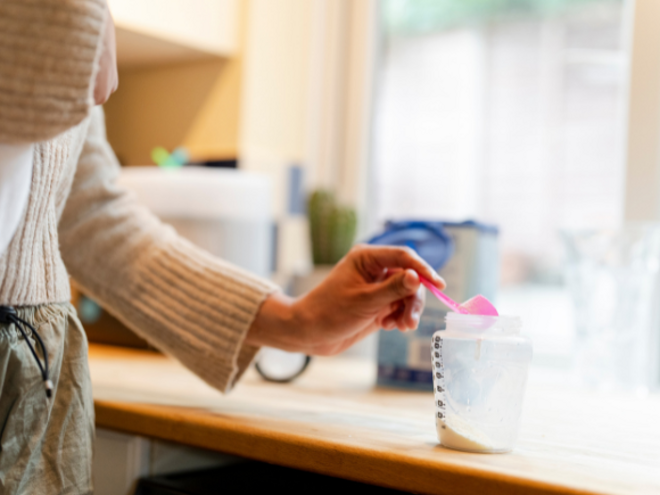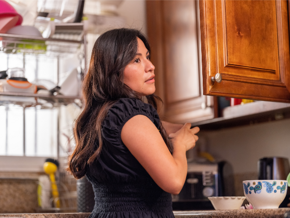
It can be confusing with so much information out there. Hopefully the following preparation points will help you and your baby get through it without too much stress!
Here are some top tips to remember when preparing baby formula:
- Clean the bench or surface on which you will be preparing the feed;
- Wash your hands thoroughly with soap and dry them on a clean cloth or paper towel;
- Wash all your equipment thoroughly with hot soapy water before use; This includes the obvious pieces such as bottle and teat, but don’t forget the knife you may use to level the scoop or any other storage containers you use. Sterilisation of this equipment is also important. Keep the sterilised equipment covered until it is used;
- More information on sterilisation techniques. Make up one feed at a time. It is safer to feed immediately after prepared. Some manufacturers do not recommend making up feeds in advance. The longer you store made-up formula, the greater the risk of bacterial growth. If you do feel you need to prepare in advance, for example for a babysitter, try having the cooled pre-boiled water ready in the bottle, and a separate storage container with the exact amount of powder needed, labelled with your child’s name and the date. Then all they need to do is mix the two together then feed the baby;
- Follow the preparation instructions and feeding table on the tin you are using. Only use the scoop provided in that tin, this is really important as different formulas will have different scoop sizes, which will affect the dilution of the formula; Do not change proportions of powder except on medical advice, incorrect preparation can make your baby very ill;
- Boil water first and let it cool to the required ‘lukewarm’ drinking temperature. Warming prepared bottles of formula above ‘lukewarm’ increases the risk of nutrient damage;
- Always pour the water into the bottle first, followed by the correct number of scoops of powder. Level off the powder in the scoop using a sterile knife (refer to your tin’s feeding table for number of scoops) or inner rim of the can. When determining the correct quantity to feed, remember that the feeding table on the tin is just a guide. You will need to monitor your baby’s desires for more or less of the made-up formula;
- Shake the bottle well (ooops, don’t forget to put the teat and lid on!) to ensure the formula is mixed well with the water. Most formulas are designed to mix well, so this should happen quite easily;
- Test a small amount on the inner part of your wrist to ensure the temperature is warm, not hot. Using your wrist as a thermometer is simple and very effective, our body temperature is around 37°C which is perfect for a baby to drink – just like breast milk temperature. If you can feel it on your skin then it may be either too hot or too cold (although too cold is way better than too hot!). If you can’t really feel it, it’s around the perfect 37°C mark;
- It’s safer to feed immediately after preparation;
- Discard any baby formula left at the end of that feed;
- Return the scoop to the baby formula tin, seal the lid tightly, and store in the recommended place as per the instructions on your tin (e.g. a cool and dry place).
- Always hold your baby and supervise while feeding. Leaving your baby unattended may cause choking.
Things you should never do when making up your baby formula:
- NEVER use another scoop other than the one provided in the tin you are using.
- NEVER dilute your baby formula – The feeding table on a baby formula tin is there to be used as a guide. Your baby may need more or less than what is advised on the feeding table. If this is the case, it is important to continue to make the feed as per the mixing instructions, then simply feed more, or less, depending on your baby’s need. Diluting the formula may cause harm to your baby by not providing adequate nutrients they need to grow healthily.
- NEVER concentrate your baby formula – For the same reasons as stated above, deviating from the mixing instructions on the tin may cause your baby harm. Concentrating your baby’s formula may put them at risk of dehydration, and harder, dryer bowel motions which may be difficult to pass.
- NEVER combine two different formulas to make up one feed.
- NEVER heat baby formula in a microwave. Microwaves don’t heat foods evenly and can create ‘hot spots’ which may burn your baby if ingested.
- NEVER create your own baby formula recipe.
- NEVER add infant cereal or other foods to formula as this can interfere with a baby’s feeding.
Read more about: What's in Baby formula, Baby formula feeding concerns, Baby bottle feeding equipment
IMPORTANT NOTICE: Breast milk is best for babies and provides ideal nutrition. Good maternal nutrition is important for the preparation and maintenance of breastfeeding. Introducing partial bottle feeding could negatively affect breastfeeding and reversing a decision not to breastfeed is difficult. Professional advice should be followed on infant feeding. Infant formula should be prepared and used exactly as directed or it could pose a health hazard. The preparation requirements and cost of providing infant formula until 12 months of age should be considered before making a decision to formula feed.



